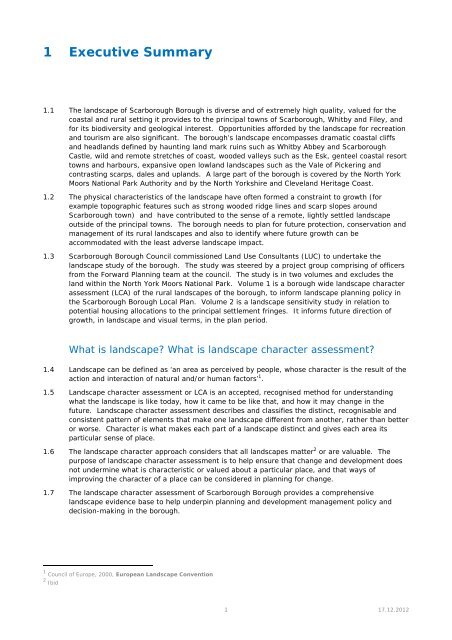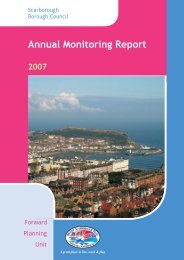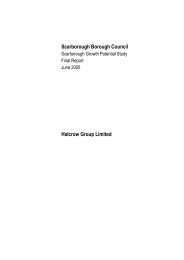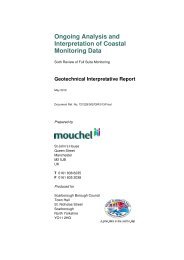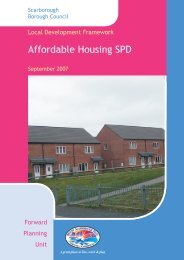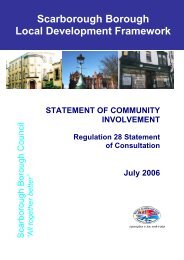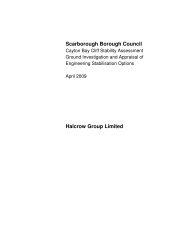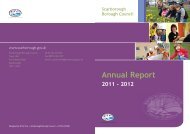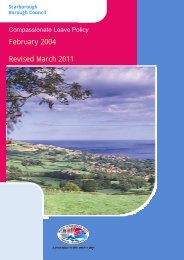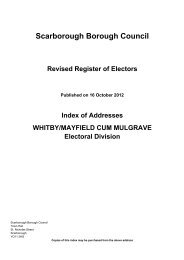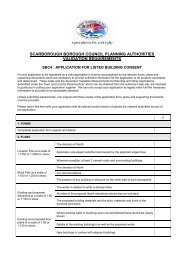Executive Summary - Scarborough Borough Council
Executive Summary - Scarborough Borough Council
Executive Summary - Scarborough Borough Council
You also want an ePaper? Increase the reach of your titles
YUMPU automatically turns print PDFs into web optimized ePapers that Google loves.
1 <strong>Executive</strong> <strong>Summary</strong><br />
1.1 The landscape of <strong>Scarborough</strong> <strong>Borough</strong> is diverse and of extremely high quality, valued for the<br />
coastal and rural setting it provides to the principal towns of <strong>Scarborough</strong>, Whitby and Filey, and<br />
for its biodiversity and geological interest. Opportunities afforded by the landscape for recreation<br />
and tourism are also significant. The borough’s landscape encompasses dramatic coastal cliffs<br />
and headlands defined by haunting land mark ruins such as Whitby Abbey and <strong>Scarborough</strong><br />
Castle, wild and remote stretches of coast, wooded valleys such as the Esk, genteel coastal resort<br />
towns and harbours, expansive open lowland landscapes such as the Vale of Pickering and<br />
contrasting scarps, dales and uplands. A large part of the borough is covered by the North York<br />
Moors National Park Authority and by the North Yorkshire and Cleveland Heritage Coast.<br />
1.2 The physical characteristics of the landscape have often formed a constraint to growth (for<br />
example topographic features such as strong wooded ridge lines and scarp slopes around<br />
<strong>Scarborough</strong> town) and have contributed to the sense of a remote, lightly settled landscape<br />
outside of the principal towns. The borough needs to plan for future protection, conservation and<br />
management of its rural landscapes and also to identify where future growth can be<br />
accommodated with the least adverse landscape impact.<br />
1.3 <strong>Scarborough</strong> <strong>Borough</strong> <strong>Council</strong> commissioned Land Use Consultants (LUC) to undertake the<br />
landscape study of the borough. The study was steered by a project group comprising of officers<br />
from the Forward Planning team at the council. The study is in two volumes and excludes the<br />
land within the North York Moors National Park. Volume 1 is a borough wide landscape character<br />
assessment (LCA) of the rural landscapes of the borough, to inform landscape planning policy in<br />
the <strong>Scarborough</strong> <strong>Borough</strong> Local Plan. Volume 2 is a landscape sensitivity study in relation to<br />
potential housing allocations to the principal settlement fringes. It informs future direction of<br />
growth, in landscape and visual terms, in the plan period.<br />
What is landscape? What is landscape character assessment?<br />
1.4 Landscape can be defined as ‘an area as perceived by people, whose character is the result of the<br />
action and interaction of natural and/or human factors’ 1 .<br />
1.5 Landscape character assessment or LCA is an accepted, recognised method for understanding<br />
what the landscape is like today, how it came to be like that, and how it may change in the<br />
future. Landscape character assessment describes and classifies the distinct, recognisable and<br />
consistent pattern of elements that make one landscape different from another, rather than better<br />
or worse. Character is what makes each part of a landscape distinct and gives each area its<br />
particular sense of place.<br />
1.6 The landscape character approach considers that all landscapes matter 2 or are valuable. The<br />
purpose of landscape character assessment is to help ensure that change and development does<br />
not undermine what is characteristic or valued about a particular place, and that ways of<br />
improving the character of a place can be considered in planning for change.<br />
1.7 The landscape character assessment of <strong>Scarborough</strong> <strong>Borough</strong> provides a comprehensive<br />
landscape evidence base to help underpin planning and development management policy and<br />
decision-making in the borough.<br />
1 <strong>Council</strong> of Europe, 2000, European Landscape Convention<br />
2 Ibid<br />
1 17.12.2012


